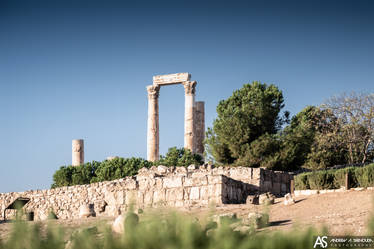ShopDreamUp AI ArtDreamUp
Deviation Actions
Description
[Download for details] The kings of the Achaemenid Dynasty had their tombs carved into the rocks at the place now known as Naqsh-e Rostam (نقش رستم). The tombs are certainly impressive enough to draw the link between them and the mythical hero Rostam, the son of Zâl, and a protagonist of the epic Shahnameh.
But they belong to four historical kings: on this picture, on the left, is the tomb of Darius the Great (King of Kings from 522-486 B.C.), a great administrator and builder, who also had to deal with numerous revolts given his tenuous links to the dynasty. The tomb on the left belongs, probably, to Artaxerxes I (465-424 B.C.). Unlike the tomb of Darius, there is no inscription that actually proves this association. The probable tombs of Xerxes I (486-465 B.C.) and Darius II (423-405 B.C.) are nearby.
The tombs, close to the royal residence of Pârsa (Persepolis) were visible from afar, and thus proclaimed the eternal glory of the Great Kings of Persia. Later, the Sassanid dynasty added rock-carved reliefs to them. Underneath the tomb of Darius, Bahram II (274-293 AD) had himself depicted in a cavalry combat against Romans. The relief underneath the tomb of Artaxerxes I shows Hormuzd II (302-309 AD), also in a cavalry charge, possibly against an Armenian, underneath a weathered depiction of his successor, the great Shapur II (309-379 AD).
Between them is one of the most famous reliefs, to the glory of Shapur I the Great (240-270 AD) along with two Roman Emperors. Under Philip the Arab (244-249 AD), Rome was forced to beg for a peace treaty from Shapur: hence the Emperor is shown on his knees before the mounted king. Shapur himself, in his elaborate crown, holds Valerian (253-260 AD) by the hand: to the shame of the Romans, the emperor had not only lost the Battle of Edessa, but actually been taken prisoner. His exact fate remains uncertain: later writers, Christians who resented Valerian for his persecutions, claim he was constantly humiliated and later tortured to death; Persian sources largely portray Shapur as being a generous victor.
The tombs are located in Fars Province, Iran, 12 km from Persepolis.
:origin()/pre15/c6fd/th/pre/i/2016/138/b/6/the_victorious_king_by_syltorian-da2x1mu.jpg)
But they belong to four historical kings: on this picture, on the left, is the tomb of Darius the Great (King of Kings from 522-486 B.C.), a great administrator and builder, who also had to deal with numerous revolts given his tenuous links to the dynasty. The tomb on the left belongs, probably, to Artaxerxes I (465-424 B.C.). Unlike the tomb of Darius, there is no inscription that actually proves this association. The probable tombs of Xerxes I (486-465 B.C.) and Darius II (423-405 B.C.) are nearby.
The tombs, close to the royal residence of Pârsa (Persepolis) were visible from afar, and thus proclaimed the eternal glory of the Great Kings of Persia. Later, the Sassanid dynasty added rock-carved reliefs to them. Underneath the tomb of Darius, Bahram II (274-293 AD) had himself depicted in a cavalry combat against Romans. The relief underneath the tomb of Artaxerxes I shows Hormuzd II (302-309 AD), also in a cavalry charge, possibly against an Armenian, underneath a weathered depiction of his successor, the great Shapur II (309-379 AD).
Between them is one of the most famous reliefs, to the glory of Shapur I the Great (240-270 AD) along with two Roman Emperors. Under Philip the Arab (244-249 AD), Rome was forced to beg for a peace treaty from Shapur: hence the Emperor is shown on his knees before the mounted king. Shapur himself, in his elaborate crown, holds Valerian (253-260 AD) by the hand: to the shame of the Romans, the emperor had not only lost the Battle of Edessa, but actually been taken prisoner. His exact fate remains uncertain: later writers, Christians who resented Valerian for his persecutions, claim he was constantly humiliated and later tortured to death; Persian sources largely portray Shapur as being a generous victor.
The tombs are located in Fars Province, Iran, 12 km from Persepolis.
:origin()/pre15/c6fd/th/pre/i/2016/138/b/6/the_victorious_king_by_syltorian-da2x1mu.jpg)
Image size
5472x3648px 5.65 MB
Make
SONY
Model
DSC-RX100M3
Shutter Speed
1/800 second
Aperture
F/5.6
Focal Length
13 mm
ISO Speed
125
Date Taken
Apr 14, 2016, 1:42:05 PM
© 2016 - 2024 Syltorian
Comments24
Join the community to add your comment. Already a deviant? Log In
i'd like to find and piss on xerxes' grave

































